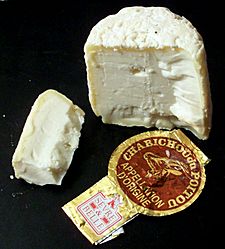Chabichou facts for kids
Quick facts for kids Chabichou |
|
|---|---|
 |
|
| Other names | Chabichou du Poitou |
| Country of origin | France |
| Source of milk | Goats |
| Pasteurized | Sometimes |
| Texture | Semi-soft |
| Named after | Lua error in Module:Wikidata at line 70: attempt to index field 'wikibase' (a nil value). |
Chabichou (also known as Chabichou du Poitou) is a special kind of French goat cheese. It is semi-soft and has a natural rind. This cheese is made from unpasteurized milk, but sometimes pasteurized milk is allowed. Chabichou has a firm and creamy texture.
It is shaped like a small cylinder, which is called a "bonde." This name comes from the shape of a wine barrel's bunghole. Chabichou cheese is usually aged for 10 to 20 days. It is very white and smooth. When you taste it, it feels flexible and has a mild goat smell.
Contents
History of Chabichou Cheese
The story of Chabichou cheese goes back a long time. It is said to have started around the year 732. This was after a big battle called the Battle of Poitiers. Many Arabs were defeated in the area. Some of them stayed there with their families and their goat herds.
The land was perfect for goats to graze. Goats were often called the "poor man's cow" because they were easy to keep. The cheese was first called "cheblis," which means "goat" in Arabic. Over time, this name changed to "chabichou." However, goats were likely kept in this area even before Roman times.
Chabichou du Poitou: A Special Cheese
Chabichou du Poitou is a specific type of Chabichou. It is made only in the northern part of the Nouvelle-Aquitaine region in France. This cheese received its special AOC status in 1990. AOC is a French certification that protects where and how certain foods are made. This helps make sure the cheese is always high quality.
Chabichou du Poitou is known for its unique label. Its production grew to 555 tons in 2003. This cheese was first mentioned in a French travel guide in 1782. Its production increased when wine making slowed down in the late 1800s. This happened because of a plant disease called phylloxera. Production grew even more when cooperative dairies started in 1906.
The area where Chabichou du Poitou can be made is limited. It includes the south of Vienne, the Deux-Sèvres area, and the north of the Charente. You can find more information on the official website of Chabichou du Poitou at http://www.chabichou-du-poitou.eu.
How Chabichou is Made
Chabichou of Poitou is made from fresh, whole goat's milk. First, a small amount of a special liquid is added to the milk. This liquid helps the milk to coagulate, or thicken. This process takes about 24 hours, at a temperature between 20 and 22 degrees Celsius.
Next, this thickened milk, called curd, is carefully put into special molds. These molds are shaped like a cylinder with a wider top. The cheese is left to drain for 18 to 24 hours. During this time, it is turned over two or three times. The temperature is kept at 22 degrees Celsius.
After draining, the cheeses are taken out of their molds. They are then salted, either with dry salt or by dipping them in a salt water bath called brine. Then, the cheeses are placed in drying rooms. Here, they continue to drain for 24 to 48 hours.
Finally, the cheeses are moved to special cellars to mature. These cellars are kept at temperatures between 10 and 12 degrees Celsius. The air is also very humid, between 80% and 90% humidity. The cheese stays here for at least 10 days. Most Chabichou cheeses are aged for two or three weeks. Some are even kept for months to develop a stronger flavor.
See also
 In Spanish: Chabichou du Poitou para niños
In Spanish: Chabichou du Poitou para niños


